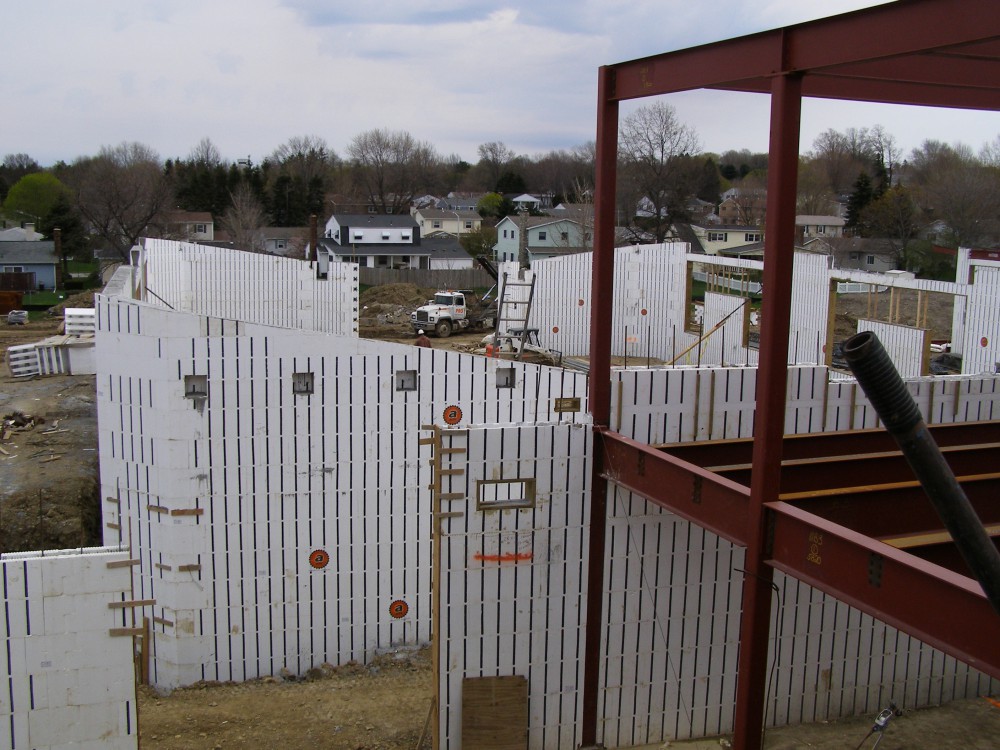Posted on July 23, 2020
The use of insulated concrete forms (ICFs) on university campuses is evident in Pennsylvania and across the country. Leadership values the durability, safety and energy-efficiency of ICFs.
ICF buildings on university campuses are built to last. In fact, they are up to 8.5 times stronger than wood-framed buildings. Research conducted by the Portland Cement Association confirms impact resistance exceeding 200 mph.
The ICF concept unites the best attributes of prefabrication and on-site customization. Molded plastic webs hold the dual EPS panels together. Precise assembly occurs in a controlled manufacturing setting. The ICF forms leave the factory as lightweight fold-flat units. They are ready for transportation to the construction site.

Advantages of ICFs for Universities
Here’s a more detailed review of the advantages of ICF construction.
Leadership in sustainability
Universities want to demonstrate a commitment to sustainability. The Lombardo Welcome Center at Millersville University is an excellent example. The welcome center has the distinction of being Pennsylvania’s first Net Zero building. First, designers specified ICF construction to lower energy requirements. Then, they added rooftop solar panels and dozens of geothermal wells.
Energy savings
The next zero structure at Millersville University saves approximately $5,000 per month in energy costs.Long-term energy savings go a long way toward justifying an investment in ICF construction. Other university ICF projects reduce heating and cooling costs, month after month, year after year.
The energy-efficiency of ICF construction is the result of multiple factors. First, the plastic foam is about 95-percent air, making it an effective insulator. Second, continuous insulation eliminates thermal bridging. Third, the ICF “sandwich” (foam-concrete-foam) delivers an airtight building envelope.
Universities often report energy savings of 30-50 percent compared with other code-compliant options. Savings multiply with the addition of passive solar designs and onsite renewable energy.
Future utility rate increases increase the savings at universities investing in ICF construction.
Comfort
Airtight ICF construction minimizes drafts. ICF exterior walls excel at keeping occupants warm in the winter and cool in the summer. Optimized comfort enhances the learning experience.
Sound transmission
ICFs typically boast a sound transmission class (STC) rating of 50 and above. This is one of the reasons you’ll find more ICF dormitories in the United States and Canada. For many students, dorm rooms are places to sleep, study and socialize. Controlling sound transmission from one room to another improves the overall experience.
Long-term maintenance savings
With aging buildings, maintenance costs mount. This fact alone often drives the decision to replace them. With ICFs, you can eliminate repair costs associated with other forms of construction. For example, ICFs reduce maintenance costs due to mold, mildew and pests.
Storm safety
ICF walls resist flying projectiles. Debris impact testing demonstrated just how tough ICF construction is. Buildings in Pennsylvania must withstand extreme winds. Hurricanes, tornadoes, thunderstorms and nor’easters are all threats in the state. Wind gusts exceeding 80 mph accompanied Hurricane Sandy on October 29-30, 2012. An F5 tornado was among the 21 that touched down in Pennsylvania on May 31, 1985.
Universities must consider the long-term when they approve new buildings. Climate change suggests that storms may become more severe in the future.
Fire protection
Fire-resistant walls, floors, roofs, doors, windows and vents all contribute to safety. Depending on thickness, ICF walls have a fire-resistance rating (FRR) of two to four hours. ICF interior and exterior walls provide important passive fire protection. ICF structural components help to stop the structural failures associated with fires.
ICF Case Studies: University Construction
Here are examples of ICF construction at North American universities.
Laurier University
Waterloo, Ontario is home to a 14-story residence hall that became the highest load-bearing ICF structure in North America at completion. Laurier University’s King’s Court houses up to 383 students. Despite the height, the ICF part of the project took just five months to complete.
Eastern Kentucky University
ICF construction has an established track record in Kentucky. The state is home to dozens of ICF buildings at both schools and universities.
In 2017, Eastern Kentucky University opened two residence halls featuring ICF construction. Martin Hall and New Hall B are each five stories high. The buildings also include classrooms, group study areas, a community kitchen and a recreation room.
The use of concrete was integral to many aspects of the two residence halls. Eight-inch ICF load-bearing exterior walls get extra support from interior steel beams and columns. These steel supports are inside an eight-inch metal-framed corridor wall. The foundation includes concrete drilled piers on bedrock. Concrete shear walls contribute to lateral stability. This resists both wind and seismic activity. Floors consist of eight-foot precast panels covered with three inches of concrete.
Chandler-Gilbert Community College
Ironwood Hall is a 60,000 sqft building at Arizona's Chandler-Gilbert Community College. Architype Review notes, “An innovative use of Insulated Concrete Forms (ICFs) as a primary component of the building envelope also contributed to Ironwood Hall’s sustainability goals.”
The LEED Gold-certified structure features extensive use of ICFs. Ironwood Hall uses an estimated 28 percent less energy than similar buildings. Its high LEED rating sets a precedent for future campus development.
The facility was specifically designed to reduce energy consumption and carbon emissions. Crews removed some of the recyclable foam to expose the concrete at lower levels.
Learn More
The Pennsylvania Aggregates and Concrete Association encourages architects, developers and decision makers to specify concrete. Are you planning a new building on your university campus? If so, feel free to contact us for assistance with additional resources.
